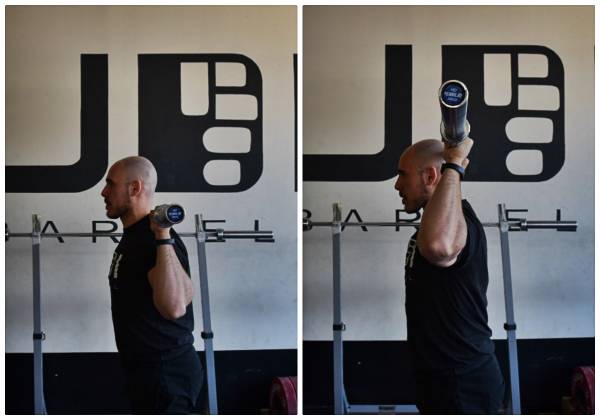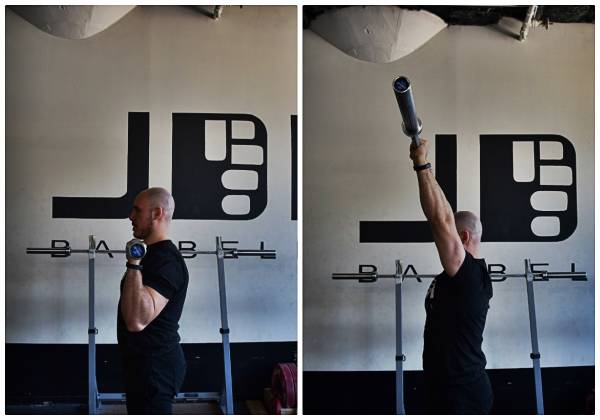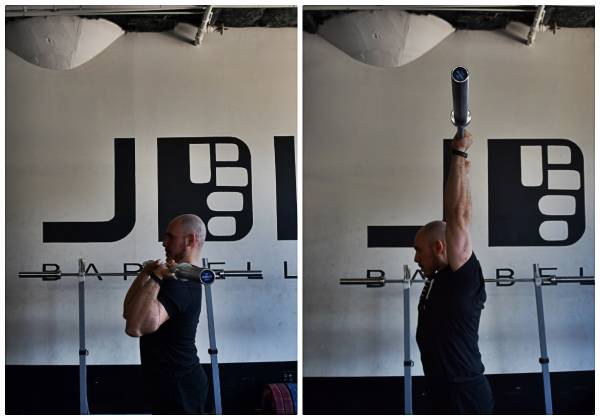The strict standing barbell overhead press gets a bad rap. Many recreational lifters will blame it for their shoulder pain. Others get frustrated because it seems so simple, yet it can be so difficult to train. But there’s nothing wrong with the lift itself; there is something wrong with how some people do it or load it.
The strict standing barbell overhead press gets a bad rap. Many recreational lifters will blame it for their shoulder pain. Others get frustrated because it seems so simple, yet it can be so difficult to train. But there’s nothing wrong with the lift itself; there is something wrong with how some people do it or load it. If a lifter has the adequate available range of motion and proper mechanics in the shoulder and thoracic spine, any problem associated with the overhead press is due to a misunderstanding of proper lift mechanics or a poor sense of how to create tension, relaxation, and balance in the body.
If you’re an average weight trainer and you exclude the overhead press from your training program, you’re limiting your overall muscular and strength development.
When looking at the overhead press, there are five common problems that lifters encounter which can lead to developing pain or stagnation in the overhead press. I’ll dive into the root cause of each problem and give you strategies and techniques for each so that you can safely and effectively train the overhead press.
Poor Bar Positioning
Whenever a barbell moves away from your center of gravity as you press or pull it, excessive forces and stresses can be placed on the body. In the case of an overhead press, if a lifter presses the bar away from their face and shoulders, the structure supporting the load, that of the shoulder, is exposed to more fatigue and force than necessary if the bar was pressed in a better position. It’s also obviously much harder to move a heavy object the further away it is from your body.
At the top of the press, the barbell should be centered over the base of your neck, which will be supported sufficiently by the center of the hip and balanced over the midfoot.
To practice the proper bar path, you have to first feel the correct overhead position. To do this, start out with a PVC pipe or empty barbell resting behind your head on your neck. Make sure the bar is resting on your shoulders right up against the base of your neck and, while keeping your neck neutral, press the barbell straight up, skimming the back of your head as you do. If you keep the bar in contact with the back of your head as you press, you will be in the correct position overhead. Hold this position, feel it, and repeat.

After you’ve practiced this position, place the bar in the front rack position, resting on the top, front part of the shoulders. Before you press, it’s important to set the elbows in the correct position. Some newer lifters have difficulty with the overhead press not because they don’t have the capacity to do the movement, but rather because they don’t understand the correct trajectory of the bar. The bar should be pressed at a slight backward angle to move it from the front of your body to the correct end position over the base of the neck.
To do this, it’s important to set the front rack position with your elbows slightly in front of the bar, rather than directly under. This will help ensure the correct bar path to the end position, behind the neck, rather than incorrectly in front of the face.

An incorrect elbow position at the start results in the bar path angling forward.

A correct elbow position at the start enables a correct, stacked finish position.
If you don’t have the flexibility to rest the barbell on the shoulders in this position, don’t stress. This will come with time and training. Focus instead on making sure the shoulders are shrugged upward, the upper back is tight and extended, and elbows are angled correctly.
Excessive Body Movement
Pushing the bar forward is not the only problematic pattern when pressing overhead. Some lifters excessively shift their weight back and forward in an attempt to keep a proper bar path. “Push your head through” is a very common cue, and one that can keep a lifter from pressing the bar in front of the face. But some people misinterpret this cue and think it means they should shove their entire torso forward while pressing the bar excessively behind them.

This exaggerated position and movement leads not only to an excessive arch in the lower back, but also puts shear forces on the shoulder and rotator cuff muscles.
Once position is set and you understand where the bar should be at the top of the movement, the lift is pretty easy to perform. When pressing the bar, the shift from front to back should be very slight. Know where the barbell should be at the top of the movement, and the rest falls into place. Just as you begin to press the barbell, pull your chin back, not up, and give yourself a double chin. This will pull your chest back just enough and shift your entire center of mass slightly back. It’s not a very attractive position, but no one ever said lifting was pretty.

Keep the bar as close to your face as possible to avoid feeling the need to exaggerate your backward shift. I tell new lifters to think about trying to hit their noses on the way up.

Once the bar reaches eye height, begin shifting your chin forward of the bar slightly as you angle the bar back. Think of just peeking your head slightly through, so the barbell ends up over the base of the neck. This movement is subtler than many think, especially for those with good range of motion in their shoulders.

By internalizing the correct positions and practicing the correct bar path, the body can work in a safer and more efficient manner to push heavier weight without pain and discomfort.
Cutting the Press Short
If you spend enough time around Olympic weightlifting coaches, you will often hear them tell their weightlifters to push up on the bar at the completion of the jerk.

These coaches are essentially telling their lifters to shrug their traps and shoulders upwards. This active position will force the traps and upper back musculature to contract and engage to help support the load overhead. Without this active contraction, the shoulder and all its passive structures would be supporting the brunt of the weight and stress. Many weightlifters will also practice their strict and push press with this same finish position.

While less experienced lifters may not have this same scapular and gleno-humeral control or stability, it’s important to understand where this finish position is and how to practice it.
The shrugging motion often puts the humeral head in a better position, and the bar stacked over the base of the neck, hips, and midfoot. With the help of these scapular stabilizers, the shoulder is no longer working independently of the upper back musculature. This will allow for heavier and more volume of pressing without any shoulder concerns.
Incorrectly Prioritizing Shoulder Position
Coaches and lifters like to argue over what position the shoulder should be rotated in. Some prefer an exaggerated externally rotated position (think armpits pointed forward while barbell is overhead), while others cue an internally rotated position where the elbows are angled back behind the lifter. While I do have a preference for my Olympic weightlifters, I’m less concerned with what direction the humeral head (the ball of the shoulder) is rotated and more concerned with it being set correctly in the socket.
When the humeral head translates (falls) forward, the lifter runs into problems of instability, impaired force production, and stressful forces that cause injury. Forcing an exaggerated external or internal rotational position at the expense of keeping the humeral head in the plane of the shoulder blade leads to a host of problems.

Pressing Too Often and Progressing Too Fast
Most think of the overhead press as an upper body lift like a bench press, and don’t truly understand how neurologically taxing the lift really is, and to what extent it fatigues the musculature of the body.
When you press a heavy barbell overhead, not only do the shoulders and back have to stabilize and move the weight, but the trunk, torso, and legs work to support the weight and ensure the prime movers can do their job. The entire body works together to stabilize, balance, and create force to press and hold the weight overhead. Since so many muscles are involved in the lift, and so much coordination of the body is needed, lots of fatigue is accumulated fairly quickly from it.
The more fatigue accumulated from a lift, the more recovery is needed from it. For a lift like an overhead press, it’s important to make sure enough time passes between heavy sessions. A good rule to follow is to make sure seventy-two hours pass before you train the lift heavy again. This means that the lift can only be trained heavy two times a week, but I’ve found that once a week is enough for many beginner, early intermediate, or even advanced lifters who haven’t used the press recently in their training. A lighter recovery day can be mixed into this to add another day of pressing, but make sure to give enough time between heavy or very voluminous overloading sessions.
Progression in volume and load from week to week should be slow for the same reason: adequate rest needs to be taken between sessions. Because so much muscle is fatigued and there is not much margin for error in the lift, increasing weight or volume too quickly will lead to stagnation or regression. I’ve had lifters get very frustrated with how slow they progress in the overhead press and I quickly remind them that they can’t expect to see the same increase in strength as their bench press. The lift cannot be grinded out. In a bench press, a lifter can change the angle at which they press if they reach a sticking point, and sometimes manage to finish a lift that they really struggled with. But in an overhead press, the moment you move the bar out of the correct path, the lift becomes almost impossible to do.
If you’re new to the overhead press and want to include it in your training, use a slowly-progressing wave loading scheme. This will help you improve at a manageable pace. Keep the same set and rep scheme and add no more than five pounds each week. Pick a starting weight that you know you can do multiple sets with at the prescribed rep range. For example:
- Week 1: 3 sets of 5 – 100lb
- Week 2 :3 sets of 5 – 105lb
- Week 3: 3 sets of 5 – 110lb
- Week 4: 3 sets of 5 – 115lb
- Week 5: 3 sets of 5 – 105lb
- Week 6: 3 sets of 5 – 110lb
- Week 7: 3 sets of 5 – 115lb
- Week 8: 3 sets of 5 – 120lb
With a little planning and some insight as to how and when to use the overhead press, it can be a fantastic tool to build overall strength and muscle. Learn to be efficient and smart in its use and with patience, you can definitely benefit from it.
Jesse competes in the sport of Olympic weightlifting, and he was also formerly a competitive powerlifter. He was featured in main strength and fitness publications. You can read more of his work on his website.






